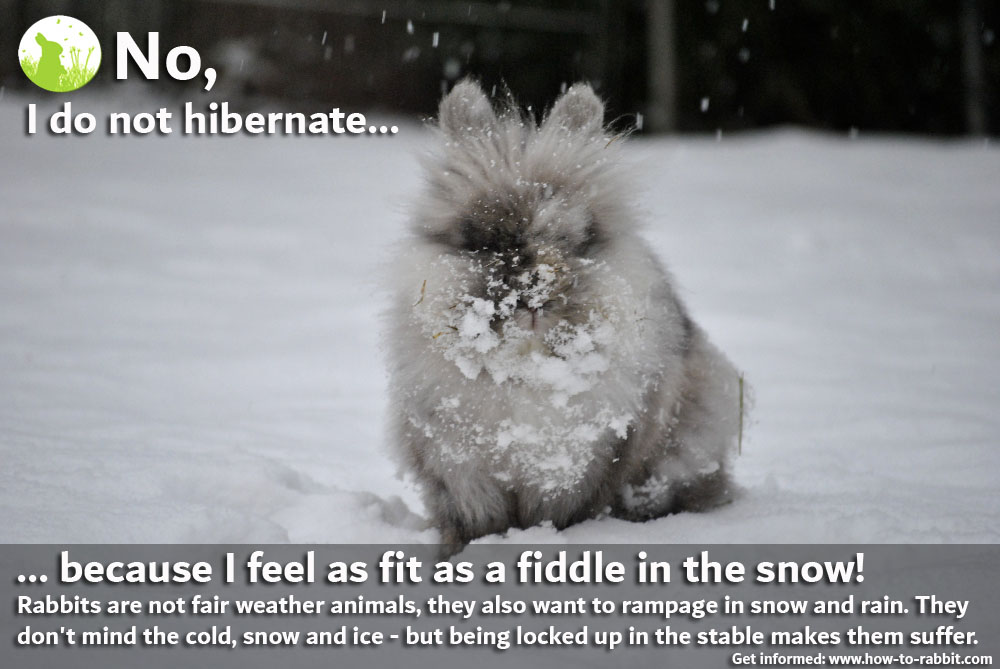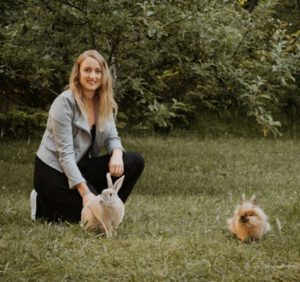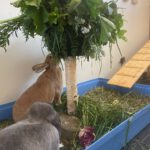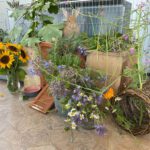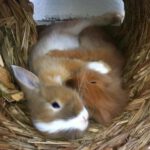
For those who have the opportunity, it is advisable to house their rabbits outdoors. Outdoor housing is possible year-round, but it requires some precautions to provide the rabbits with a comfortable living space.
General requirements for rabbit housing:
- Adequate Size: At least 6m² of floor space day and night for two rabbits (see minimum dimensions for rabbits – a rabbit hutch is too small).
- Sun, Shade, and Fresh Air (Note: The sun moves!)
- Weather Protection (from wind, rain, snow, drafts…)
- Varied, species-appropriate, and interesting furnishings, environmental stimuli
- Protection against predators (marten, fox) and escape
- Hygiene
Contents
- No rabbit wants to live in a rabbit hutch!
- The Rabbit Hutch and the Rabbit Enclosure
- How large should the enclosure and the rabbit hutch be?
- To meet the basic needs of the rabbits in the enclosure, they require:
- How should the enclosure be set up?
- How to make the enclosure fox and marten-proof?
- How should the ground be designed?
- Tips for Building an Enclosure
- Is a shed, a garden house, a barn, or a garage suitable as accommodation?
- The Rabbit Hutch
- What can I use as a rabbit hutch?
- How do I protect the enclosure from wind and weather?
- Making the rabbit hutch winterproof
- Additional run for the daytime?
- How do I acclimate rabbits to outdoor housing?
- More Infomations
No rabbit wants to live in a rabbit hutch!
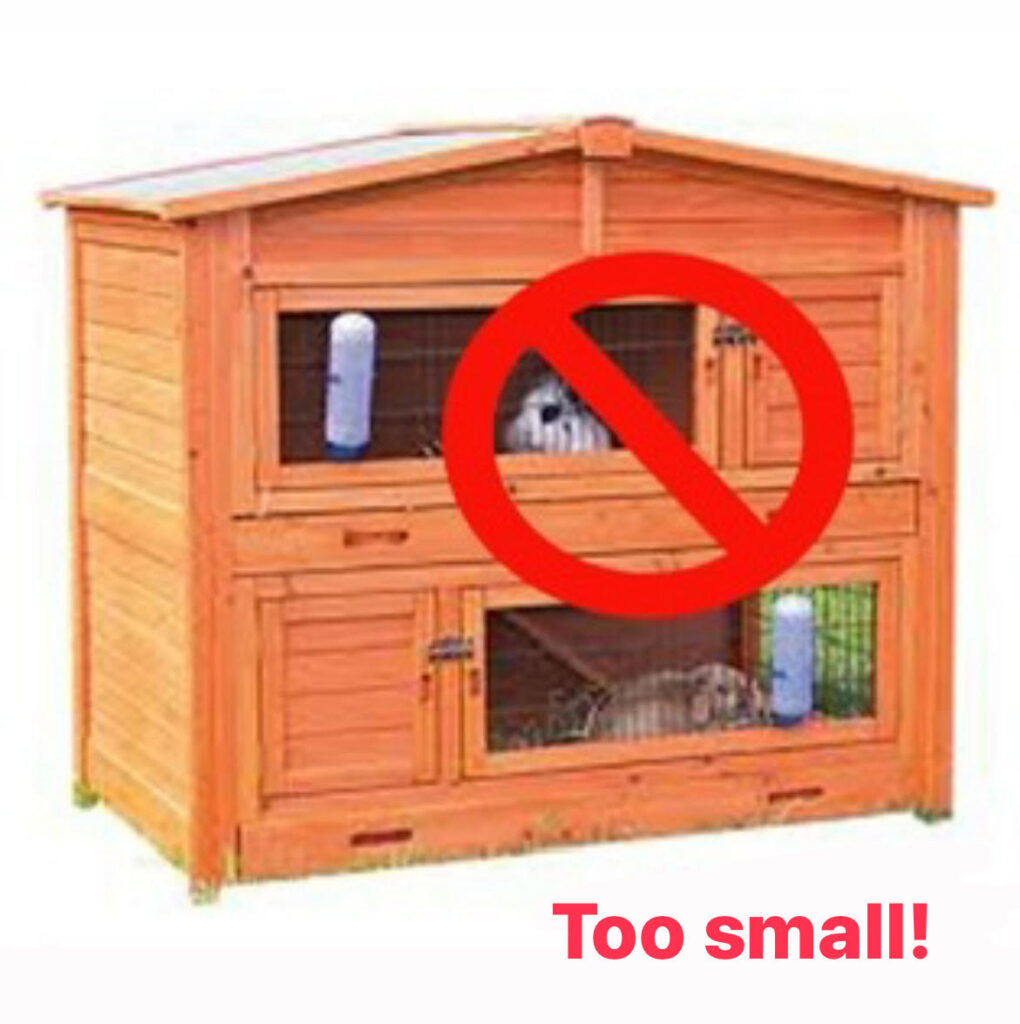
Even though this form of housing is widespread, no rabbit wants to be confined to a rabbit hutch. Hutch housing is torture for rabbits:
- In a hutch, rabbits cannot move in a species-appropriate manner; they cannot run, make sudden turns, dig, avoid other rabbits, engage in chases, or really let loose.
- Often, there are severe injuries or incompatibilities due to the confined space. Similar to when we are locked in a guest bathroom with a good friend, the lack of space frequently leads to aggression in animals. The animals cannot avoid or withdraw.
- Rabbits are crepuscular, meaning they do not sleep through the night (as humans or many other animals do) but are active at night as well. Therefore, they need a lot of space day and night.
- Many rabbits develop behavioral disorders out of boredom and engage in undesirable activities, such as gnawing heavily on the hutch from the inside, nibbling on the bars, licking a spot in their fur raw, or performing stereotypical movements.
- Hutch housing leads to spinal deformities and joint damage in these active animals. For example, the thigh bone structure is not fully developed, and due to the permanent incorrect posture, there is pathological curvature of the spine. Digestive problems often occur due to lack of movement.
- A hutch becomes a mini-oven in the summer and a refrigerator in the winter. These animals are trapped inside and exposed to temperatures, unable to warm up through movement and activity.
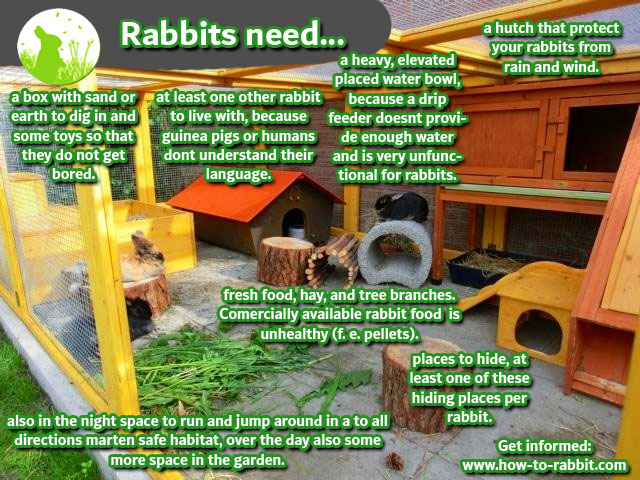
The Rabbit Hutch and the Rabbit Enclosure

A rabbit habitat is not just a „shelter“ but the living space for many years. Therefore, it should be appropriately designed to meet the needs of the rabbits.
Every rabbit enclosure consists of a rabbit hutch and a large, marten-proof, partially covered enclosure. Both must be securely connected so that the rabbits can choose where they want to stay at any time – even at night!
How large should the enclosure and the rabbit hutch be?
The enclosure should accommodate the rabbits‘ strong desire for movement and should therefore be sufficiently spacious, allowing them to run and play. We recommend a minimum size of 10 m², or for rabbits that are allowed to have a very large outdoor run every day from morning to evening and are only confined at night, a minimum of 6m² for the night enclosure area. For example 3m x 2m by 1m. For those who prefer imperial measurements: 3m=9’10”, 2m=6’7″, 1m=3’3″.
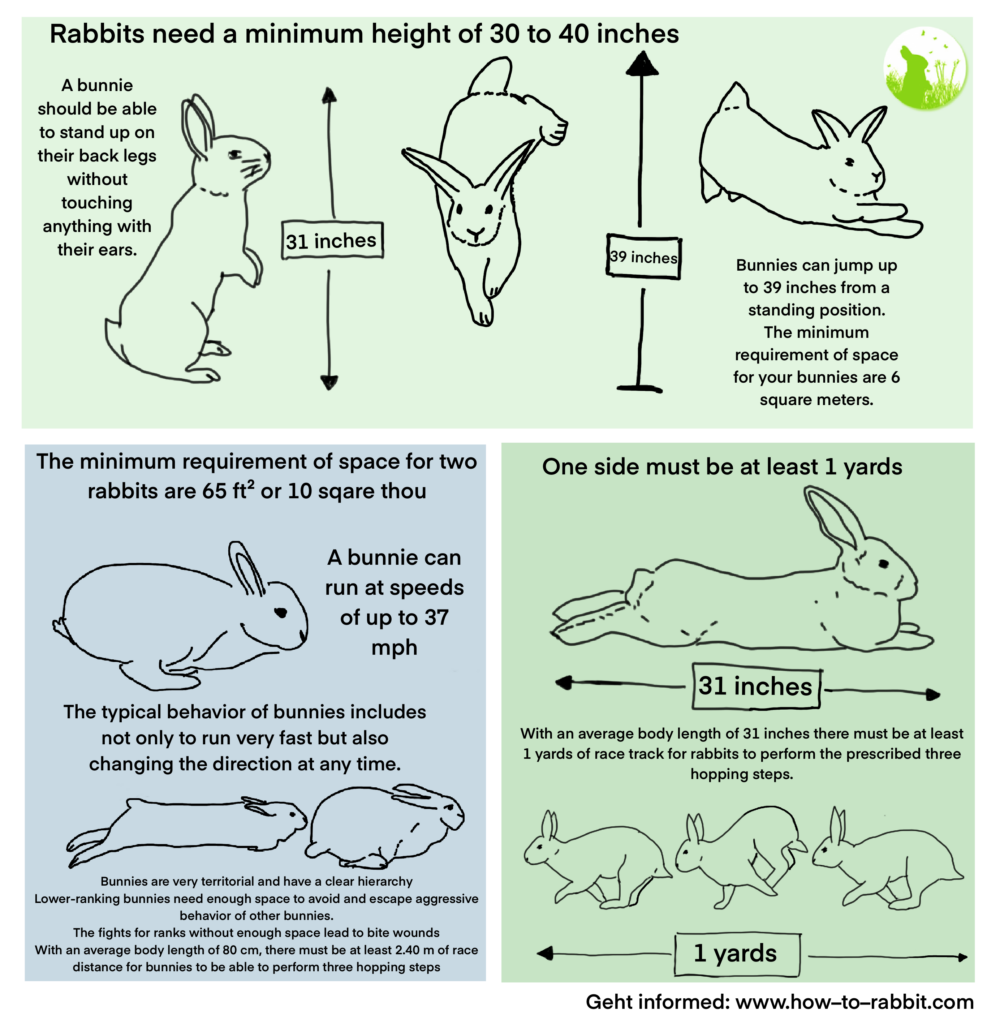
To meet the basic needs of the rabbits in the enclosure, they require:
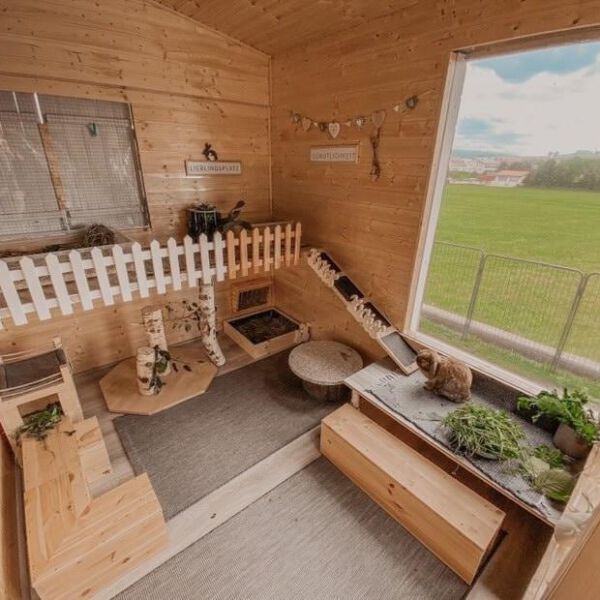
- Increased seating areas (platforms, hutch roofs)
- A digging box
- Rabbit Houses, hiding spots (at least one per rabbit)
- Varied furnishings
- Chewable materials (fresh branches, natural materials)
- Cozy spots, scattered bedding areas
- Different materials (bedding, stone slabs, wood…)
- Unobstructed space for running
- Toilet trays
- Feeding area with racks for hay and
- a stable water bowl
Caution: There is a lot of equipment that is in violation of animal welfare and can be dangerous to rabbits!
How should the enclosure be set up?
There are different construction methods, each with its own advantages and disadvantages:
- Walk-in enclosures (easier to clean, allows interaction with the rabbits, expensive, may not be feasible in rented gardens)
- Knee-high enclosures (ideal for rented gardens or small spaces, easier to build, less easy to clean)
- Pyramid enclosures (less bulky and easier to build than fully walk-in enclosures, but still easily walkable and cleanable)

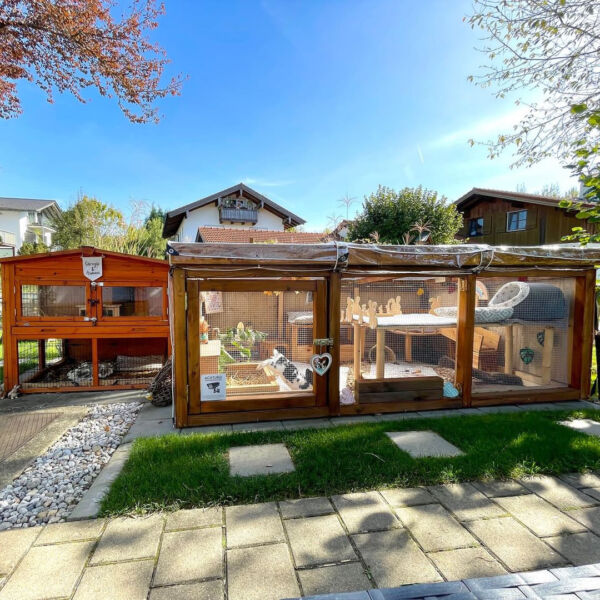
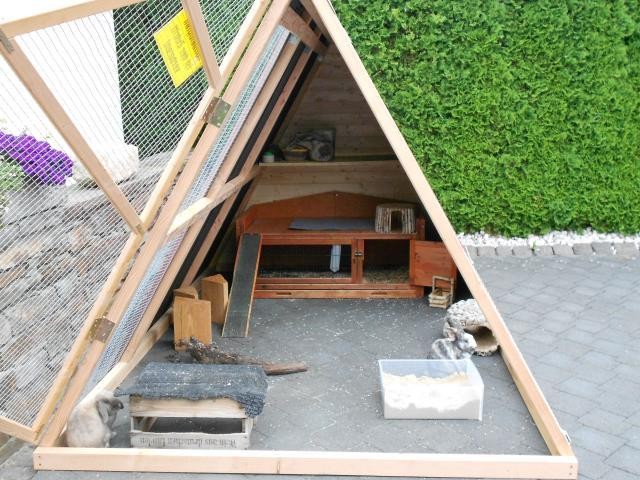
How to make the enclosure fox and marten-proof?
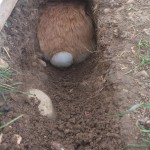
To ensure protection against predators, the outdoor run must be constructed entirely marten-proof on all sides – including both below and above! Only aviary wire is marten-proof; regular rabbit wire and nets are not.
How should the ground be designed?
Rabbits can quickly escape, while predators may dig their way in! Therefore, it is recommended to lay paving stones, which are hygienic and provide effective protection against digging attempts. Rabbits often enjoy stone slabs, even if they seem cold and unwelcoming. In winter, you can cover them with wood chips, pine mulch, or bedding. Those who want to maintain a natural lawn in their permanent enclosure often find themselves with mud and collapsed tunnels after a short time. However, a natural lawn can be used as the ground in the daytime outdoor run.
Tips for Building an Enclosure
Don’t be afraid of building an enclosure! There is a suitable solution for every owner, even if you’re not particularly handy. Garden sheds or children’s playhouses can be used as hutch, and for aviaries, there are suitable ones available from aviary builders. For further inspiration and a fitting solution, it can also be helpful to look at existing aviaries or to be inspired by other rabbit keepers.
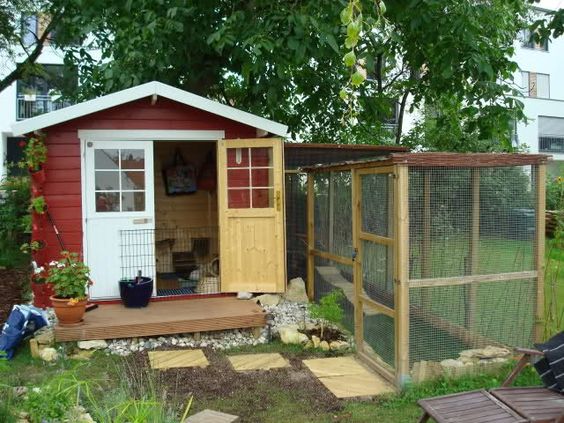
Is a shed, a garden house, a barn, or a garage suitable as accommodation?
Closed quarters are only suitable if either an enclosure can be used by the rabbits around the clock, or during the day, in addition to the closed space, there is a large free-roaming area, garden, or enclosure that the rabbits are allowed to enter. The rabbits should never be enclosed during the day in such accommodation. An exception can be very large „spaces“ with good air circulation and windows/daylight.
The Rabbit Hutch
A hutch is essential to protect the rabbits from weather influences. The rabbits seek out this area on their own when it is too cold, drafty, or wet. They should never be confined in such a hutch!
What can I use as a rabbit hutch?
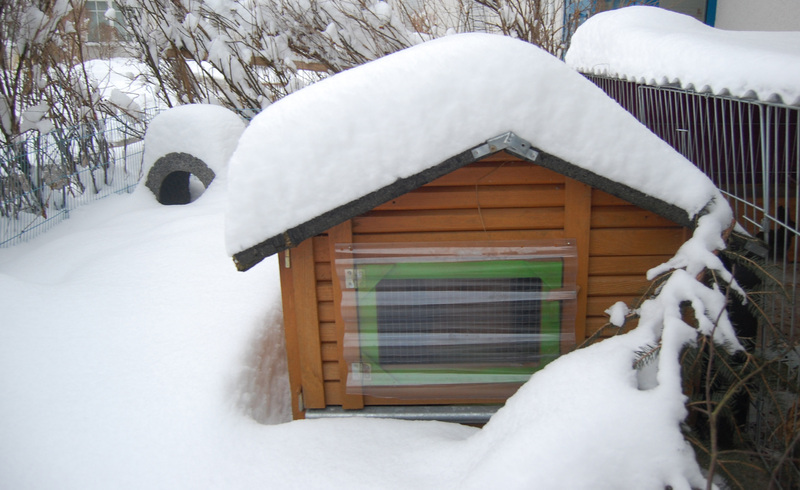
This can be a commercially available hutch or a doghouse. However, these hutches are usually quite drafty and may need retrofitting (marten-proof closure, overhanging roof, thicker back wall, etc.). Their lifespan is usually quite short. We have had good experiences with this hutch and with doghouses. It is also possible to build a hutch yourself.
Experienced owners often prefer garden houses or children’s playhouses as hutches. They are durable, stable, marten-proof, walk-in, and, due to their size, longevity, and the saved material when it comes to the size of the enclosure, much more affordable than commercially available rabbit hutches.
For adequate air circulation, air holes must be drilled in the upper part of the hutch, and these should not be placed on opposite sides (and not on the weather side) to avoid drafts.
It is important that the hutch is absolutely wind and rainproof, and a minimum floor space of 100 x 50 cm is sufficient for two dwarf rabbits. For larger groups or larger breeds, a correspondingly larger floor space is necessary. Offering multiple hutches may also be sensible.
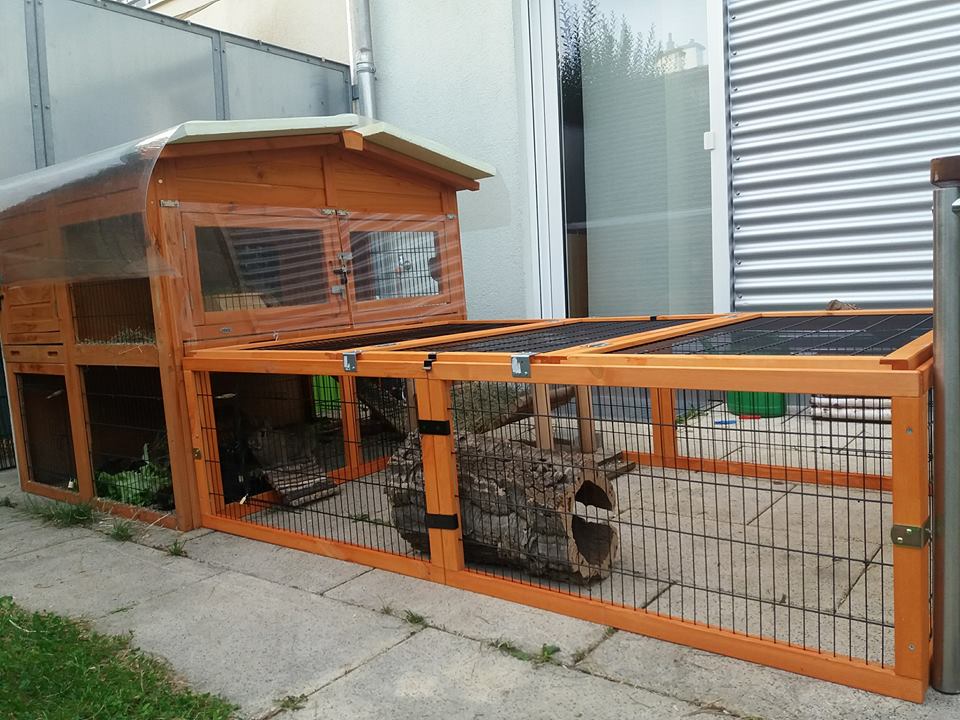

How do I protect the enclosure from wind and weather?
We recommend covering a portion or even the entire enclosure. Many rabbits prefer sitting under a roof, avoiding the hutch. This also provides them with dry areas during bad weather. Additionally, it is easier to keep the enclosure clean and hygienic, and there is more space for furnishings that are not weather-resistant. This covering often serves as good shade in the summer, although natural shade from trees would be even better (Caution! The sun moves). Corrugated sheets or twin-wall polycarbonate panels are suitable as a roof, or alternatively, roofing felt can be applied to wood.
Depending on the weather, at least the side facing the elements or even all sides should be protected. It’s best to enclose two sides completely and use tarps or other flexible weather protection on the other two sides, allowing for sufficient ventilation in the summer and weather protection in the winter:
- Covering with tarps and sheets, which can be securely fastened!
- Roll glass or
- Wooden cladding
Making the rabbit hutch winterproof

If the hutches have a mesh, in winter, a Plexiglas or a wooden board should be installed in front of it, or alternatively, you can hang a blanket or a carpet in front of it during cold weather. Additionally, the hutch should be generously padded with hay and straw. These hutches do not need to be insulated, and plastic covers for hutches, which can be purchased in stores, are not advisable. Both prevent ventilation, causing poor air and moisture buildup, leading to harmful mold growth, and many rabbits may suffer from skin fungi. A cuddle partner is essential to warm up the hutch; individual rabbits freeze in winter. Rabbits should never be confined in a hutch; it would be equivalent to staying in a small refrigerator. Rabbits need plenty of space, variety, and companionship to stay fit and active in winter, move around a lot, and keep warm.
Further information: Rabbits happily and healthily overwintering in the garden
Additional run for the daytime?
Rabbits are very active and lively animals that require a lot of variety and space. Therefore, a small enclosure of just a few square meters does not do justice to their needs. It is even more important that they have access to a run in outdoor housing.
Many owners let their rabbits run around in their densely fenced, well-planted, and structured gardens during the day. It is also possible to connect a flexible run on the grass to the fixed enclosure. Enclosure elements of 6- or 8-sided runs are well-suited for this purpose, and they can be expanded as needed. Many shelters or a net (e.g., a fruit tree net) placed over the run provide protection against birds of prey. To prevent it from sagging, you can drive a stake into the center and stretch it over the top.
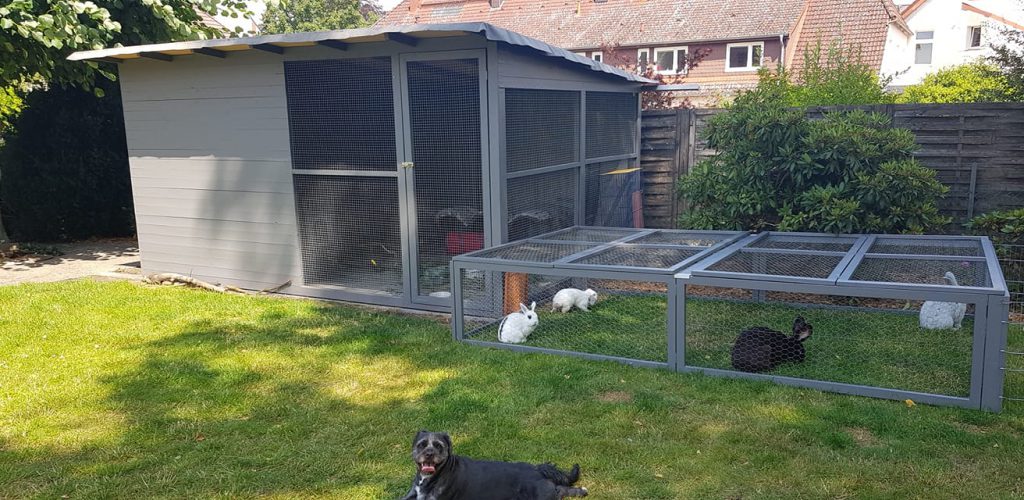

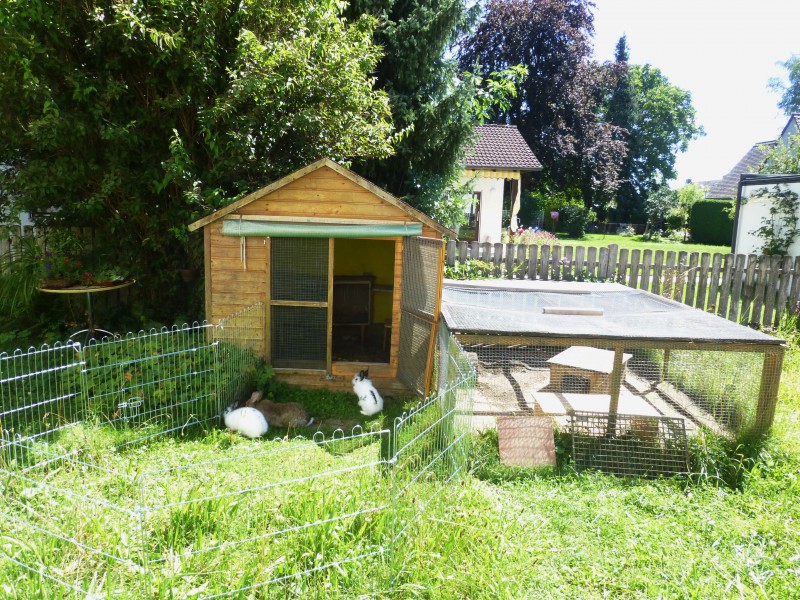
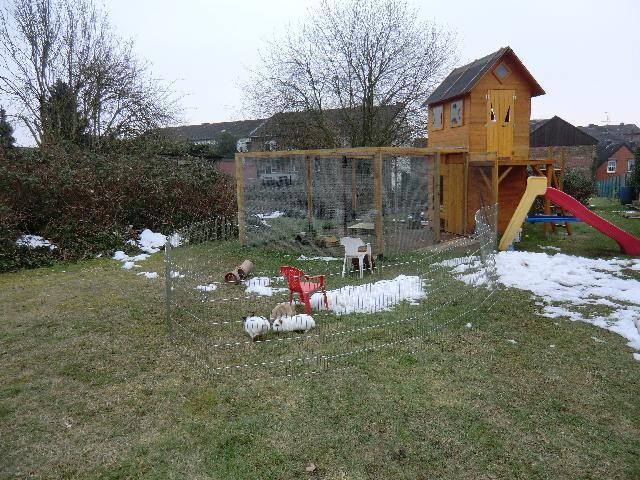

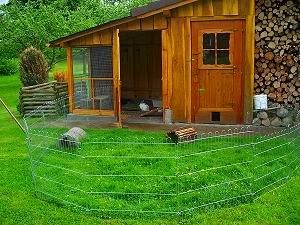
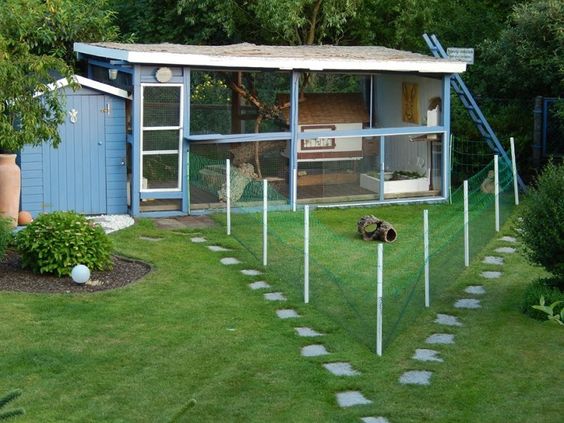
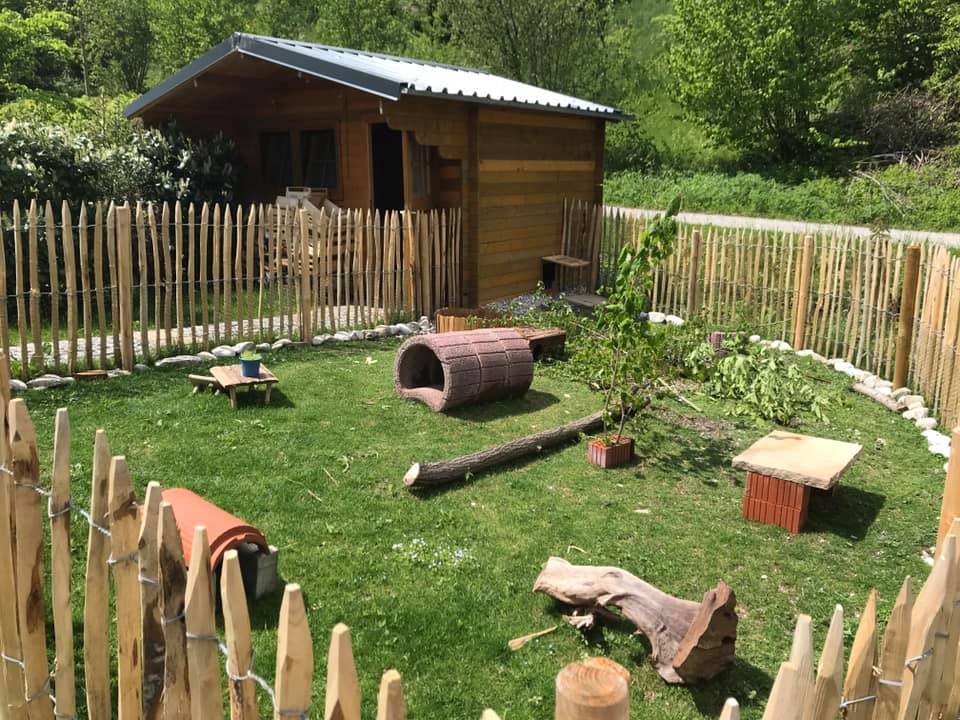

How do I acclimate rabbits to outdoor housing?
In summer, rabbits can be comfortably transitioned to outdoor housing, provided it is a garden house or another stable, weather-protected shelter, and a large, partially covered, marten-proof outdoor run that is accessible day and night and securely connected to the shelter. Two to three closed sides in the outdoor run are ideal. Under no circumstances should rabbits be confined to a standard hutch, not even „only at night“!
During the winter months, acclimatization should be done gradually through an unheated room.
